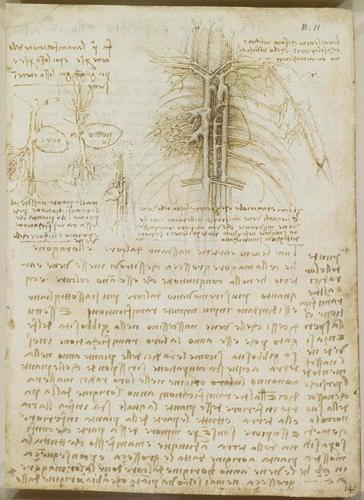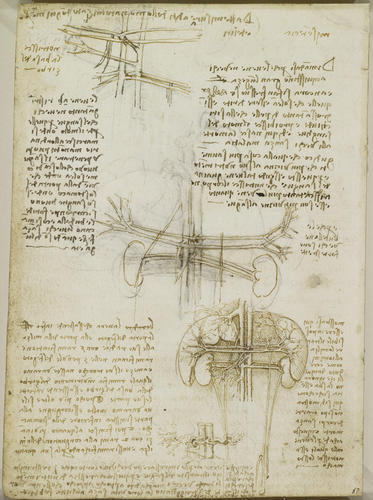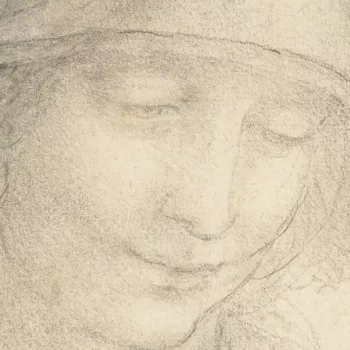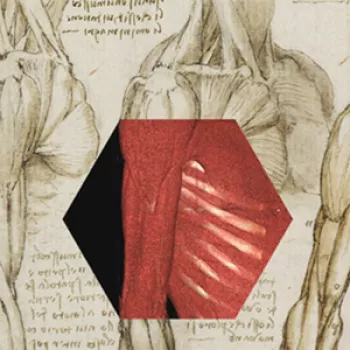Recto: The heart compared to a seed. Verso: The vessels of liver, spleen and kidneys c.1508
Pen and ink over black chalk | 19.2 x 14.0 cm (sheet of paper) | RCIN 919028
-
A folio from Leonardo's 'Anatomical Manuscript B'.
Recto: an attempt to resolve the ancient debate about the centre of the venous system, by appeal to the analogy of a plant:
"All the veins and arteries arise from the heart. And the reason is that the largest veins and arteries are found at their conjunction with the heart, and the further they are removed from the heart, the finer they become, dividing into very small branches. And if you say that the veins have their origins in the gibbosity of the liver because they have their ramifications there, just as the roots of plants have in the earth, the reply to this comparison is that plants do not have their origin in their roots, but the roots and other ramifications have their origin from that lower part of the plant which is situated between the air and the earth. And all the lower and upper parts of the plant are always less than this part which adjoins the earth ... and in consequence, the veins take their origin from the heart, where they are biggest."Accordingly at upper left Leonardo has drawn, on the left, the heart (labelled core) with the vena cava and the hepatic and renal veins, and on the right a peach stone (labelled noccolo) with its branching stem and roots. The hepatic veins were analogous to the roots of the plant as the liver was believed to be the source of nourishment, which was carried by the venous system throughout the body (and indeed everything in the gastrointestinal tract absorbed by the veins must travel through the liver). But Leonardo did not accord the heart undue importance: in a contemporary note on RCIN 919050 he stated ‘The heart in itself is not the origin of life, but [simply] a vessel made of dense muscle vivified and nourished by an artery and a vein, as are other muscles.’
The principal drawing shows networks of veins entering the vena cava at two points: this may be intended as a double trunk to the hepatic vein, but as the upper junction is opposite the right atrium it is more likely that Leonardo had confused the position of the right pulmonary vein, which actually returns to the left atrium. What appears to be a third ‘great vessel’ between the vena cava and aorta is the azygos vein (whose prominent arch is well depicted), shown as receiving intercostal venous drainage symmetrically and draining into the superior vena cava. A straight vein entering the vena cava at the junction of the brachiocephalic veins might be the thyroidea ima, present in a minority of human subjects. But the formation of the superior vena cava is too symmetrical (in humans the left brachiocephalic vein is long and oblique, and the right brachiocephalic vein shorter and almost vertical), and the aortic arch with its single branch is configured as in ungulates such as the cow.
Verso: A study of the vessels of the liver, spleen and kidneys. Unusually, the drawings show Leonardo struggling to make sense of his dissection notes. The connections between the vessels are repeatedly drawn (both in chalk and in ink) and are thus rather confused in the upper two studies, and only in the third drawing does Leonardo arrive at a clear, if partially correct, arrangement. The liver, on the left of that drawing, is small, and the spleen enlarged, indicative of cirrhosis of the liver and associated portal hypertension.
In the third drawing, the aorta (on the right as we look at the drawing) gives off first the celiac axis, from which the common hepatic and splenic arteries arise (the left gastric is absent), then the superior mesenteric artery and lastly the renal arteries. The inferior vena cava receives the hepatic veins from the upper portion of the liver. The right gonadal vein is drawn as a long curve beginning by the right ureter and meeting the vena cava just below the hepatic vein. The left gonadal vein appears to overshoot its junction with the left renal vein, petering out around the splenic vein; but what Leonardo has actually shown there is a network of vessels in front of the spleen also draining into the left renal vein, and again possibly indicative of portal hypertension. The gonadal arteries are not shown.
In the central sketch there appears to be an erroneous connection from the hepatic portal vein directly into the inferior vena cava – perhaps Leonardo was trying to find a venous analogue to the celiac axis. But the superior mesenteric vein is correctly shown uniting with the splenic vein to form the portal vein, as described in the note at lower left:
"The vein which extends between the gate of the liver and the gate of the spleen has its roots in five branches which ramify in the five lobes of the liver. In the middle of its trunk a branch arises [superior mesenteric vein] which ramifies in the nutriment at the base of the omentum extending to all its parts. And a little further along a branch rises upwards and is joined to the left lower part of the stomach [probably the short gastric veins]; and then it ends in two branches at its conjunction with the spleen, and goes ramifying through its substance."
Many of the other notes are concerned with the increasing tortuosity and constriction of the vessels in the elderly, as shown in the small detail at the bottom of the page. For instance the passage at upper right asks:
"Why the veins in the aged should acquire great length, and those which used to be straight become so flexuous, and the coat thickens so much that it closes up and prevents movement of the blood. From this arises the death of the elderly without disease."
Text from M. Clayton and R. Philo, Leonardo da Vinci: Anatomist, London 2012Provenance
Bequeathed to Francesco Melzi; from whose heirs purchased by Pompeo Leoni, c.1582-90; Thomas Howard, 14th Earl of Arundel, by 1630; Probably acquired by Charles II; Royal Collection by 1690
-
Creator(s)
Acquirer(s)
-
Medium and techniques
Pen and ink over black chalk
Measurements
19.2 x 14.0 cm (sheet of paper)
Object type(s)
Other number(s)











